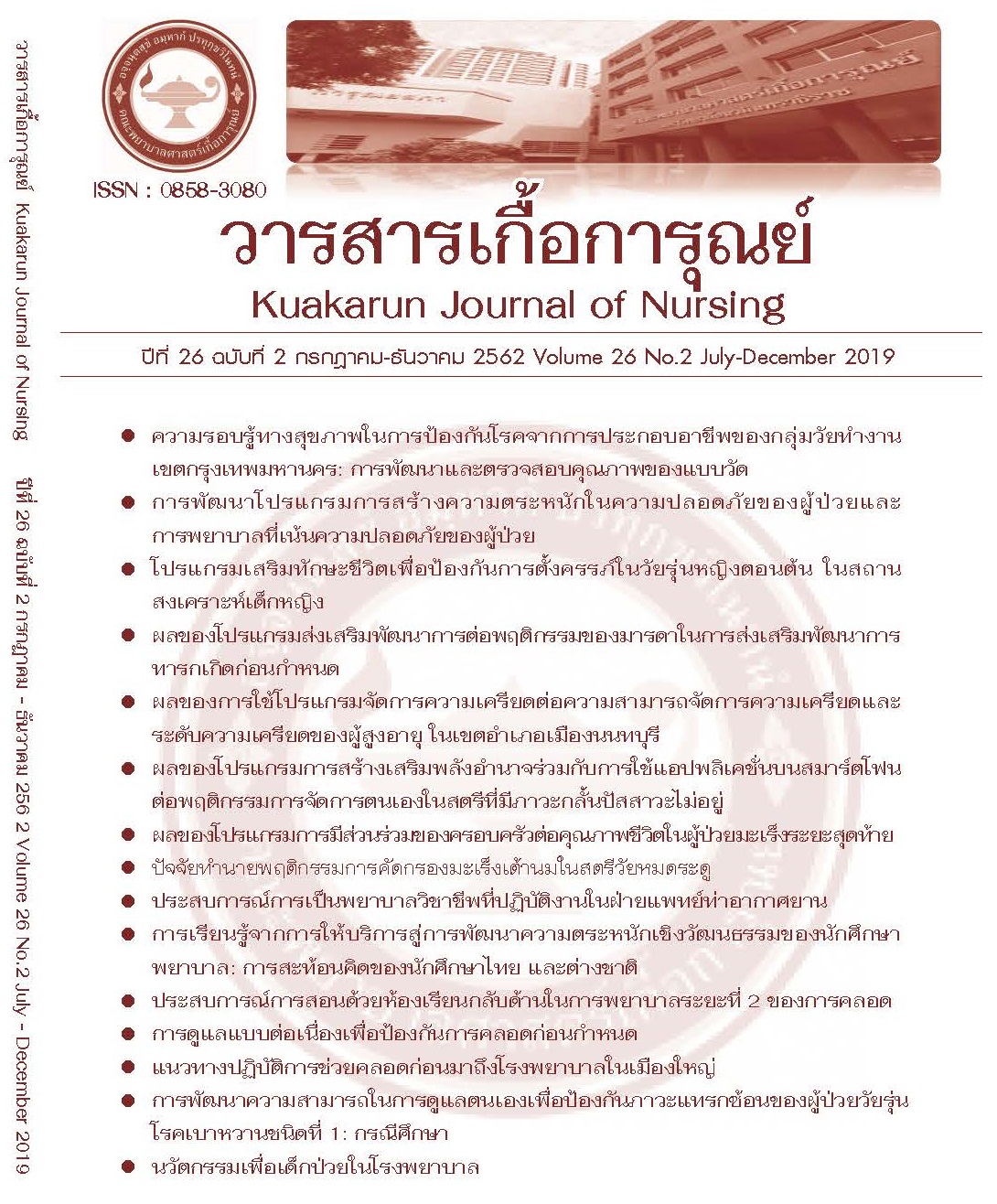โปรแกรมเสริมทักษะชีวิตเพื่อป้องกันการตั้งครรภ์ในวัยรุ่นหญิงตอนต้น ในสถานสงเคราะห์เด็กหญิง
คำสำคัญ:
โปรแกรมเสริมทักษะชีวิต, วัยรุ่นหญิงตอนต้น, สถานสงเคราะห์บทคัดย่อ
การวิจัยนี้เป็นการวิจัยกึ่งทดลอง ชนิดสองกลุ่มวัดก่อนและหลังการทดลอง และระยะติดตามผล มีวัตถุประสงค์เพื่อศึกษาผลของโปรแกรมเสริมทักษะชีวิตเพื่อป้องกันการตั้งครรภ์ในวัยรุ่นหญิงตอนต้นในสถานสงเคราะห์เด็กหญิง กลุ่มตัวอย่างเป็นวัยรุ่นหญิงอายุ 10 – 14 ปี ในสถานสงเคราะห์เด็กหญิงในประเทศไทย จำนวน 60 คน สุ่มสถานสงเคราะห์เป็นกลุ่มทดลองและกลุ่มเปรียบเทียบ สุ่มเด็กที่มีคุณสมบัติตามเกณฑ์คัดเข้ากลุ่มละ 30 คน โดยกลุ่มทดลองได้รับโปรแกรมเสริมทักษะชีวิตเพื่อป้องกันการตั้งครรภ์ในวัยรุ่นผ่านกระบวนการเรียนรู้แบบมีส่วนร่วม และแรงสนับสนุนทางสังคม กิจกรรมการเรียนรู้มีทั้งหมด 4 ครั้ง ระยะเวลา 4 สัปดาห์ ประกอบด้วย การพัฒนาความภูมิใจในตนเอง การตระหนักรู้ในตนเกี่ยวกับการเปลี่ยนแปลงทางเพศและพัฒนาการวัยรุ่น การฝึกคิดวิเคราะห์วิจารณ์เกี่ยวกับการตั้งครรภ์ในวัยรุ่นและการฝึกทักษะการปฏิเสธและการเจรจาต่อรอง เก็บรวบรวมข้อมูลโดยให้ตอบแบบสอบถามด้วยตนเองในระยะก่อนการทดลอง หลังการทดลองและระยะติดตามผล ในทักษะชีวิตด้านความภูมิใจในตนเอง ความตระหนักรู้ในตน ความคิดวิเคราะห์วิจารณ์ การปฏิเสธและการเจรจาต่อรองและพฤติกรรมป้องกัน การตั้งครรภ์ วิเคราะห์ข้อมูลโดยใช้สถิติ ร้อยละ ค่าเฉลี่ย ส่วนเบี่ยงเบนมาตรฐาน Independent t –test, Chi-square, Likelihood Ratio Fisher’s Exact test, Two way Repeated Measures ANOVA, Repeated one way ANOVA และ Bonferroni
ผลการวิจัยพบว่า กลุ่มทดลองมีผลต่างของคะแนนเฉลี่ยทักษะชีวิตความตระหนักรู้ในตนและพฤติกรรมป้องกันการตั้งครรภ์สูงกว่ากลุ่มเปรียบเทียบอย่างมีนัยสำคัญทางสถิติ (p<0.05) ส่วนคะแนนเฉลี่ยของทักษะชีวิตด้านความภูมิใจในตนเอง ความคิดวิเคราะห์วิจารณ์ การปฏิเสธและการเจรจาต่อรองพบว่าไม่แตกต่างจากก่อนทดลองและกลุ่มเปรียบเทียบ ซึ่งโปรแกรมเสริมทักษะชีวิตนี้สามารถนำไปปรับใช้ เพื่อเสริมทักษะชีวิตด้านความตระหนักรู้ในตนและการปฏิบัติพฤติกรรมป้องกันการตั้งครรภ์สำหรับวัยรุ่นในสถานสงเคราะห์ได้
เอกสารอ้างอิง
กรมอนามัย สำนักอนามัยการเจริญพันธุ์. (2561). รายงานประจำปี 2561 สำนักอนามัยการเจริญพันธุ์. สืบค้นจาก https://rh.anamai.moph.go.th/download/all_file/index/reportRH/report_rh_61.pdf
จรีภรณ์ ขวัญดี. (2555). ผลของโปรแกรมพัฒนาทักษะชีวิตต่อการป้องกันการตั้งครรภ์ในวัยรุ่น ในนักเรียนอาชีวศึกษาหญิง จังหวัดสมุทรปราการ.(วิทยานิพนธ์ปริญญาวิทยาศาสตรมหาบัณฑิต สาขาวิชาเอกอนามัยครอบครัว).มหาวิทยาลัยมหิดล. นครปฐม.
ชญาดา คล่องการ. (2556). ประสิทธิผลของโปรแกรมสุขศึกษาในการประยุกต์ใช้การสร้างเสริมทักษะชีวิตร่วมกับแรงสนับสนุนทางสังคมเพื่อป้องกันการตั้งครรภ์ในวัยรุ่น ในโรงเรียนแห่งหนึ่ง อำเภอห้วยแถลงจังหวัดนครราชสีมา. (วิทยานิพนธ์ปริญญาสาธารณสุขศาสตรมหาบัณฑิต สาขาวิชาสาธารณสุขศาสตรมหา-บัณฑิต). มหาวิทยาลัยขอนแก่น. ขอนแก่น.
เนตรทราย ปัญญชุญห์. (2552). การสร้างเสริมทักษะชีวิตเพื่อป้องกันการมีเพศสัมพันธ์ของนักเรียนหญิงมัธยมศึกษาตอนต้น จังหวัดประจวบคีรีขันธ์. (วิทยานิพนธ์ปริญญาวิทยาศาสตรมหาบัณฑิต สาขาวิชาเอกสุขศึกษาและพฤติกรรมศาตร์). มหาวิทยาลัยมหิดล. นครปฐม.
บุญฤทธิ์ สุขรัตน์ (2557). การตั้งครรภ์ในวัยรุ่น: นโยบาย แนวทางการดำเนินงาน และติดตามประเมินผล (พิมพ์-ครั้งที่ 2). กรุงเทพฯ: โรงพิมพ์ชุมนุมสหกรณ์การเกษตรแห่งประเทศไทย.
ปังปอนด์ รักอำนวยกิจ. (2556). แม่วัยใส: สถานการณ์และบริบทในสังคมไทย. โครงการสำรวจและศึกษาเพื่อเฝ้าระวังและเตือนภัยทางสังคมรอบที่ 1 (มิถุนายน-สิงหาคม 2556). กรุงเทพฯ: วิทยาลัยประชากรศาสตร์จุฬาลงกรณ์มหาวิทยาลัย.
พจนา หันจางสิทธิ์และธีรนงค์ สกุลศรี. (2557). ปัจจัยเสี่ยงที่มีผลต่อการตั้งครรภ์ในวัยรุ่น: การศึกษาเชิงคุณภาพ. ใน การประชุมวิชาการระดับชาติ ครั้งที่ 10 “ประชากรและสังคม 2557” (น. 163 – 180). กรุงเทพฯ: มหาวิทยาลัยมหิดล.
พรจิรา ปริวัชรากุล. (2556). แกะรอยหยักสมอง มองผลกระทบของการพนัน. กรุงเทพฯ: สหมิตรพริ้นติ้งแอนด์ พับลิชชิ่ง.
ยงยุทธ วงศ์ภิรมย์ศานติ์และสุวรรณา เรืองกาญจนเศรษฐ์. (2553). ทักษะชีวิต. กรุงเทพฯ: สำนักงานกองทุนสนับสนุนการสร้างเสริมสุขภาพ (สสส.).
ริษา บุนนาค. (2555). ประสิทธิผลของโปรแกรมทักษะชีวิตในการป้องกันพฤติกรรมเสี่ยงทางเพศที่นำไปสู่การมีเพศสัมพันธ์ ของนักเรียนชั้นมัธยมศึกษาตอนต้น จังหวัดนครปฐม. (วิทยานิพนธ์ปริญญาวิทยาศาสตรมหาบัณฑิต สาชาวิชาเอกสุขศึกษาและพฤติกรรมศาสตร์). มหาวิทยาลัยมหิดล. นครปฐม.
วินัดดา ปิยะศิลป์, และพนมเกตุมาน. (2550). ตำราจิตเวชเด็กและวัยรุ่น. กรุงเทพฯ: ธนาเพรส.
สำนักนโยบายและยุทธศาสตร์ กระทรวงสาธารณสุข. (2559). สถิติสาธารณสุข 2546 - 2559. สืบค้นจากhttps://rh.anamai.moph.go.th/download/.../index/.
สุภิญญา อินอิว.(2559). การตั้งครรภ์ในวัยรุ่นและบทบาทการเป็นพ่อแม่. ในรสวันต์ อารีมิตร, สุภิญญา อินอิว,
บุญยิ่ง มานะบริบูรณ์, ศิริไชย หงษ์สงวนศรี และสมจิตร์ จารุรัตนศิริกุล (บ.ก.). ตำราเวชศาสตร์วัยรุ่น: Textbook of adolescent medicine (303 - 322). นนทบุรี: ห้างหุ้นส่วนจำกัดภาพพิมพ์.
สุริยเดว ทรีปาตี. (2551). พัฒนาการและการปรับตัวในวัยรุ่น. สืบค้นจาก https://www.nicfd.cf.mahidol.ac.th/th/.../.../3.pdf.
สุวิดา ศรีฉายแสง. (2558). เหตุและปัจจัยการตั้งครรภ์ไม่พึงประสงค์ของวัยรุ่น กรณีศึกษา: บ้านพักฉุกเฉินและคลินิกวัยรุ่น โรงพยาบาลรามาธิบดี. สืบค้นจากจากhttps://www.crs.mahidol.ac.th/.../.htm.
Cobb, S. (1985). Social support as a moderated of life stress, Psychosomatic Medicine. 38(5). 300 – 314.
Polit, D.F. and Hungler, B.P. (2013). Essentials of nursing research: Methods, appraisal, and utilization (8thed). Philadelphia: Wolters Kluwer/Lippincott Williams and Wilkins.















